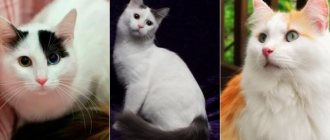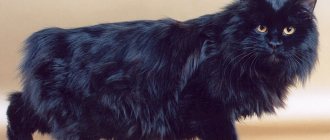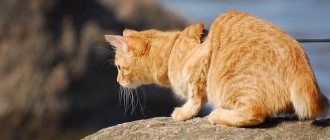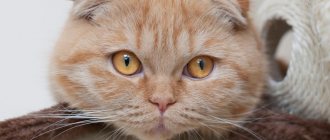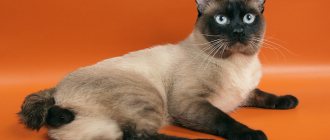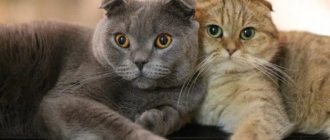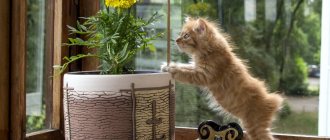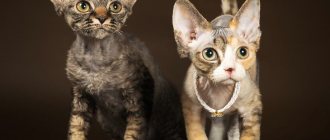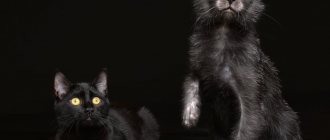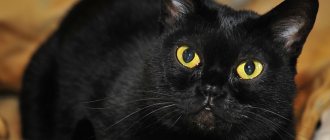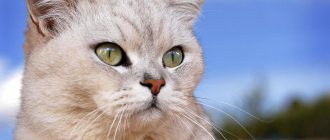The American Bobtail is a breed of cat with a short stubby tail, also known as the Snow Bob and Yankee Bob. These cats are large in size and look like lynxes. Considered a property of the United States.
They got their modern appearance thanks to their genetic purity, which the Americans took care of. The population expanded over the years, and the first mention of lynx-like cats was back in the 18th century (listed on Wikipedia).
Purebred bobtail kennels are located in North America and follow strict regulations for their breeding and distribution throughout the world.
The color of the bobtail cat is “wild”, that is, “tabby”, characteristic of show animals.
Show class - the animal breeds that most comply with the standard and are exhibition “samples”.
History of the breed
A kitten with a distinctive short tail was spotted by the Sanders couple in Southern Arizona in the 1960s, whose exact origins were unknown, but Indians claimed that one of its parents was a bobcat. The couple took the cute baby into the house where there was already a Siamese cat. The new family member was named Yodi. Yodi's joint offspring with the Siamese cat inherited a short tail, which was direct evidence of the hereditary transmission of this feature.
Neighbors of the Sanders Family, felinologists, noticed the short-tailed litter and suggested further breeding of the breed.
These cats acquired their modern appearance thanks to a breeding program for this breed since 1980. To breed cats similar to the first representative, it was necessary to search throughout North America for cats with similar characteristics.
American Bobtail kitten
The breed name "American Bobtail" was registered with TICA in 1989.
TICA is an international genetic registry of pedigree and domestic cats (International Cat Association).
Breed characteristics
It has a large size (on average 5-6 kg), a strong build and a pleasant color in the form of circles, lines, stripes, and specks.
The short tail is not the result of circumcision, but a genetic feature of a mixture of wild lynx and domestic cat. A distinctive feature of the cat is its wild disposition and predatory look; they have a fairly developed intellect and are strongly attached to their owner.
Photo of American Bobtail
There is an opinion that the bobtail is related to the Japanese bobtail. But that's not true. In the Japanese Bobtail, the short tail is a recessive mutation, not a dominant one.
Character
Yankee Bob is distinguished by good intelligence and intelligence. Ingenuity manifests itself wherever two cat paws and teeth can cope. This pet will watch with great curiosity what its owner does: how he uses the light switch, household appliances, opens doors and handles from the water tap, and then begins to repeat.
The owners of American Bobtails note that with any obstacles to freedom (cages, bags, boxes), they will show determination and open any mechanism if it is not locked.
This breed is not prone to aggression. Her curiosity will manifest itself well in doing household chores together, walking, playing or traveling.
Color
The Sanders family chose the color point color (a colored mark on the face) to cross Jodi with other representatives of the breed. He was a brown tabby color type.
The American Bobtail breed is characterized by different coat colors: brown, marbled, blue, cream, red, lilac, cake, chocolate, black, gray.
Tabby color in different colors
Additional information: Tabby color - a pattern on the “fur coat” in the form of circles and stripes, transmitted genetically, is similar to the patterns that wild animals have.
Head
The appearance of the bobtail muzzle
Bobtail has an elongated shape with pronounced high cheekbones. The profile is smooth. The sideburn line begins at the tip of the nose.
Muzzle
Wide, medium length, like the jaw. In the center there is a darkened spot, like in Siamese cats.
Ears
The base is wide, the tips are rounded and have tassels. There may be a white spot on the outside of the ear, regardless of the color of the cat. Located far from each other.
Eyes
They are set deep, almond-shaped, with the outer corner slightly tucked towards the ear. The eyebrows are well defined and give a stern look.
Nose
Wide and straight from base to tip. As a rule, darkened.
Body
Moderate length with an athletic build, strong bones, powerful shoulder blades and paws. The spine is straight or slightly rounded. The neck is powerful and of medium length. The chest is round and wide. The full growth process of a bobtail stops at 3 years of age.
Paws
Large and round, long-haired cats have tufts of hair between their toes.
Tail
Yankee Bob Tail
The short tail has a hock joint that is flexible and movable. Externally, it is strong and durable, and can be straight, twisted or curved. Length not less than 2.5 cm.
Wool
Woolen “pantaloons” of a bobtail.
Yankee bob cats are long-haired or semi-long-haired with a gray undercoat. There are decorations in the form of collars and pantaloons. The hair on the neck, belly, tail and paws is longer than throughout the rest of the body.
Shorthairs have a smooth but elastic coat with a soft undercoat. The tabby color has a gray undercoat.
Color and coat type
The coat color can be any. But the so-called “wild” colors, like tabby, are especially valued. The color comes in the following colors:
- creamy;
- red;
- black;
- blue;
- lilac;
- color point;
- cake;
- cinnamon;
- chocolate.
The bobtail's body is covered with thick hair. It can be short-haired or long-haired. The latter are characterized by strong fluffiness, especially on the chest, paws, and tail.
Cream Kurilian Bobtail
Black.
Blue bobtail.
Torty.
Chocolate.
Vaccinations and antiparasitic treatments
To reduce the likelihood of infectious diseases, the cat must have all the vaccinations prescribed by the veterinarian. The most basic ones are:
- calcivirosis;
- panleukopenia;
- rhinotracheitis;
- rabies;
- leptospirosis.
The first vaccinations are given at the age of 8 weeks, a month later a second vaccination is carried out, but also against rabies. They are usually placed by the breeder, and the owner receives a passport with their marks. Before vaccination, the animal must be treated for worms and other parasites. The dose of these drugs is calculated depending on the weight of the animal.
Sterilization and castration
The American Bobtail cat, not intended for breeding, needs to be sterilized. This operation should be carried out at approximately 8-10 months; after the intervention, it is necessary to provide the animal with proper care and concern.
Health
They are distinguished by good health and endurance, but some individuals are prone to allergic reactions that can occur to medications.
The allergy is accompanied by redness on the skin and itching, and dermatitis may appear. Allergy symptoms include vomiting, hair loss, diarrhea and ear infections.
Treatment of dermatitis consists of eliminating the irritant and special dietary nutrition.
To avoid allergic reactions, you should carefully use new cosmetics. If symptoms uncharacteristic for the pet are detected, drugs or care products are replaced with analogues.
Dietary recommendations
Due to the fact that it is quite difficult for inexperienced breeders to provide an animal with balanced nutrition when using natural food, veterinarians consider specialized wet and dry food to be the best option. Preference should be given to the premium class, since such crackers and canned food contain all the vitamins and minerals necessary for the growth, development and health of the animal.
Modern professional cat food is divided according to various indicators:
Important! Read the manufacturer's recommendations. The required one-time nutritional allowance is indicated on each package.
Universal recommendation for the number of feedings for a bobtail depending on age:
American Bobtail Contents
Due to their activity, these felines are well suited for private homes or large apartments. To be kept, a bobtail must have personal food bowls, a tray, a bed, and hygiene products.
Bobtail cats love outdoor walks
Bowls are selected from heavy materials, such as metal or ceramics. They can easily be trained to use a scratching post; they show no interest in furniture, wallpaper or curtains.
These cats need to purchase toys that perform specific tasks; gadgets for active games are suitable. They are well involved in the game and have good endurance.
It is necessary to create conditions on the site of a private house for the cat to leave freely or periodically take it for a walk if the pet lives in an apartment.
Nutrition
A natural diet should include lean meats (poultry, beef, lamb) after cooking. Replace with liver or low-fat sea fish.
To ensure a balanced diet, soft porridges with sufficient cooking or chopped boiled vegetables, whipped into puree, are added to the meat.
Dairy products for ambob: cottage cheese, sour cream, yogurt, kefir. Milk should not be given often, as it will have a bad effect on digestion; the fat content of the drink should be low.
Quail eggs in raw or boiled crushed form are suitable as a delicacy and natural beneficial substances.
Premium dry food
Ready-to-eat dry food is selected from the premium class (AATU Cat with Chicken, Now Natural Holistic Adult Cat, Carnilove Duck&Turkey, Hill's Science Plan Feline Adult Optimal Care with Rabbit, Acana Wild Prairie).
Feeding frequency
For 1 kg of adult cat weight - 20 g of food. It should consist of half meat, and the second part of the portion is filled with porridge or vegetables. Boiled meat should be chopped in a meat grinder or into small cubes. Dairy products are not served more than 3 times a week, eggs - no more than 4 times, fish and liver are recommended for the diet - up to 2 times a week.
To remove hairballs from the stomach, the cat must be given a paste (Beaphar Malt Paste, Nutri-Vet Pet-Ease, Beaphar Duo Active Paste, Gimpet Multi-Vitamin Paste Extra, selected according to the doctor’s recommendations).
To fully obtain the elements necessary for the pet’s health, the cat is given vitamin complexes (AniVital FeliDerm, Polidex Immunity up, Agrovetzaschita Radostin - in tablets; Beaphar Laveta Super.Petvital Energy, Nutri-Vet Probiotics Salmon Oil, VetExpert VetAminex, VitOkey - in liquid form).
Fresh grass and sprouted oats will be useful in digestion.
Appearance care
Regardless of the length of the coat, it is necessary to comb out fur and clumps using a slicker brush, a rubber brush or glove, a furminator and an iron brush.
Grooming will allow you to remove excess fur, especially during the molting period, and avoid large volumes from entering the stomach when licking.
Washing is carried out at least 2 times a month for long-haired cats, and no more than 1 time in 1.5 months for short-haired cats. At a water temperature of 39 degrees. Bath procedures are carried out using cat shampoos (Jerob Herbal shampoo, BioGroom Proteine-lanoline, Royal Groom, Tropiclean “Papaya”, Rolf Club, Veda Fitoelita, Iv San Bernard Banana).
Grooming
When purchasing shampoo, you should consider the length of the coat and follow the recommendations on the packaging.
Ear cleaning should be done once a week, thoroughly cleaning the auricle with a lint-free piece of cloth or a thin cotton pad.
The eyes are wiped with lotion or chamomile solution daily.
Teeth brushing is carried out with a silicone brush once every 2 days. If the cat does not allow thorough cleaning, oral hygiene is supplemented with toothpaste for cats.
Claws are trimmed as they grow. Only the transparent part is cut with special scissors without damaging the shape.
Castration and sterilization
Kittens of this breed are not sold for breeding, or there are strict rules according to which the American Bobtail can breed in the nursery itself. Representatives of this breed are sold already spayed or neutered and have a corresponding mark in the pedigree.
Exhibition participant
The operation is performed at 8-10 months of age by the breeder.
In order to maintain the purity of the breed, self-breeding of bobtails is prohibited, at least their kittens cannot be registered with TICA as purebred.
Castration and sterilization
There is an opinion that sterilization or castration is a lot of stress for animals. However, in reality it is quite the opposite. Of course, surgical intervention is a serious thing, but if the animal is not planning to reproduce, ailments associated with the cat’s search for a partner, or the cat marking its territory, will become much more stressful for both the pet and the owner.
A castrated or sterilized animal pays great attention to its owner and seeks his affection.
Castration, that is, cutting out the genital organs, of cats is carried out between 7 and 12 months, and sterilization - a more gentle way of performing the operation - after 8 months. Cats, regardless of the type of intervention, are operated on at the age of 10 months to 1.5–2 years. To determine the exact timing of the procedure, you must contact your veterinarian.
After the operation, it is necessary to provide increased attention to the pet and take care of its comfort by doing the following:
- During recovery from anesthesia, place the cat on the floor, having previously laid a soft bedding on this place. You need to choose a place close to the heat source, but not too close. This measure is due to the fact that the animal, upon waking up, may lose orientation in space and fall from the chair or other elevation on which it will lie at that moment.
- Rub your pet's paws to improve blood circulation and speed up recovery from anesthesia.
- Massage the animal’s eyelids every half hour. The fact is that during anesthesia, cats' eyes remain open and this causes them to dry out.
- Monitor your pet to catch the moment of recovery from anesthesia.
- Give food and water after the cat wakes up. Be prepared for the animal to refuse food; this is normal.
- The cat will have to wear a bandage for 3 days that will cover the seam. This is a hygienic measure, which, as a rule, does not require any additional actions from the owner, since the blanket is put on immediately in the clinic.
Cats wear a blanket after surgery to protect the suture.
Breeding
This breed is bred in nurseries under a unified program and with a license. There are more than 700 representatives of this breed worldwide. The demand for kittens of this breed is too great, and the queues sometimes take a long time (up to 2 years).
A kitten marked “not for breeding” cannot have offspring in the future, with their subsequent registration and sale of kittens as purebred.
American bobtail nurseries are located in North America, only there you can purchase a purebred bobtail according to the standard document.
Advantages and disadvantages
When choosing a pet for yourself for many years, it is better to get to know the characteristics of this breed. The advantages of the Yankee bob are the following characteristics:
- Life expectancy is from 12 years to 21 years.
- They are affectionate and trusting towards their owner.
- They have a good mind and intelligence.
- They do not damage property and do not cause mischief.
- They can calmly wait for the owner until he arrives and can easily find something to do.
- They do not show aggression and treat other family members and animals well.
- They do not have genetic diseases and have strong immunity.
Bobtail cats are good travel companions.
The bobtail does not have many disadvantages; for some, they will not be a reason to refuse the purchase, but you should consider:
- The high cost of a kitten and care products, including premium food.
- It is necessary to carefully observe hygiene: brush your teeth, take care of your coat, eyes and ears.
- Keeping a cat in a small apartment can negatively affect a cat’s psyche, as can frequent and prolonged absences of owners.
- Easily cope with opening windows, doors, locks.
Care and maintenance of cats
Caring for bobtails is not particularly difficult. More obstacles may arise at the very first stage, when you need to purchase a purebred kitten. The thing is that the American bobtail is quite widespread in America, but in other regions of the planet it is rare. Breeding and breeding of purebred representatives is still carried out only in the USA.
But if, after all, luck smiles and a real American bobtail settles in the house, then keeping this fluffy miracle will be a simple and enjoyable task. Cats need periodic walks in the fresh air. But at the same time, you definitely need to keep an eye on them, since the natural instinct for a free life can make itself felt.
Longhaired American Bobtails require regular brushing. There must be a scratching post in the house. Approximately once every 10-12 days, the pet needs to check its claws and, if necessary, grind them down so that they do not interfere with the soft step.
Diseases of the breed
This breeding line is considered one of the healthiest in the cat world. Purebred pets do not have hereditary diseases. However, if a close relative or an animal of unknown pedigree was involved in the breeding, then there is a risk of developing certain diseases. Most often this is:
- dysplasia;
- dermatitis;
- allergy.
If fed improperly, bobtails can develop diabetes. This most often occurs when cats are fed predominantly carbohydrate foods. To prevent this from happening, their food should include more meat.
Conclusions about the breed
global $ads_google;
//data-ad-slot=”2475549904″ $ads_google = empty($ads_google) ? false : true; ?> if ($ads_google == false) {?> $ads_google = true; ?> } ?> American bobtails are rightfully considered the favorites of their owners. Outwardly, cats have retained the features of their wild ancestors, but at the same time they are distinguished by their kind and affectionate disposition. If we add to this high intellectual abilities and an extravagant hunting look, then the authority of the breed rises even higher. All the features of the character and appearance of fluffy cats and cats evoke only pleasant emotions in everyone who has encountered them at least once in life. This unusual combination of characteristics makes snowbobs unique and inimitable creatures.
How much does an American Bobtail kitten cost?
Cats that require special attention and care are recommended for those who already have extensive experience in keeping purebred cats. Prices for kittens depend on the class:
- pet - $500;
They are sold for pet use and cannot take part in exhibitions or participate in breeding (they are sold spayed or neutered). They may have distinctive features from the standard that will not affect the health and quality of life of the pet.
- brid — up to $1000;
They can participate in exhibitions, but are sold already sterilized, neutered, or under a given condition that the buyer must comply with.
- show - up to $3,000.
Black color is a sought-after and rare color of this breed.
Cats that do not have a single disqualifying feature. They are the standard of the nursery and are sold on a “co-ownership” basis, that is, they still remain in the nursery for breeding and participation in exhibitions.
In Russia you can meet private breeders, for example in St. Petersburg, and buy an ambob kitten without an American pedigree. Purchasing such a pet will cost from 80,000 rubles.
Purchasing a kitten
When starting your search for this wonderful cat, remember that you can only buy a real American Bobtail in the USA. In Russia, Belarus and Ukraine, the American cat can only be found from private breeders at large exhibitions, but no one is currently engaged in breeding in these countries.
The price of an American Bobtail cat starts at $600 and for this amount you will only be offered a pet class. An exhibition baby suitable for breeding will cost $1,300, to which you should add the cost of transportation and registration of relevant documents.
IMPORTANT: an alternative to the American bobtail can be the Kurilian, which is not very different in appearance, but has a more Nordic character.
Breed and other animals
At any moment, the American bean will want to show a hunting instinct, so you should not raise it together with small animals (hamsters, mice, guinea pigs and birds), even keeping them in a cage, the cat can easily open the door and feast on its roommate or not calculate its strength in Game.
They will treat animals similar to their physique as wards, even a large breed dog.
Bobtails will tolerate aggressor animals with difficulty, for example, a ferret and a raccoon, but they will not start a fight themselves; rather, they will avoid communicating with someone they do not like.
Character
The American Bobtail is well suited for large families, as they become attached to all family members, not just one of them.
They get along with other pets, including dogs, and are good with children. When meeting strangers, they don’t hide under the sofa, but go out and get to know each other.
They prefer to spend time with their family rather than go out on their own. The main thing to remember is that they perfectly sense the mood of the owner; they are even used in the treatment of depression.
A large, warm, purring cat will help disperse any blues and bad thoughts.
But they themselves need no less warmth and communication, and do not tolerate loneliness and inattention well.
Playful, they often ask their owners to play with them, even to the point of bringing their favorite toy between their teeth. By the way, this speaks of a powerful hunting instinct, as wild cats carry prey.
The same instinct wakes up if a fly or other insect flies into the house in trouble. They are great at catching them on the fly.
They are average in activity and do not turn into either lazy couch cats or a perpetual motion machine that destroys the entire house.
In addition, they can be taught to walk on a leash if you live in an urban environment.
